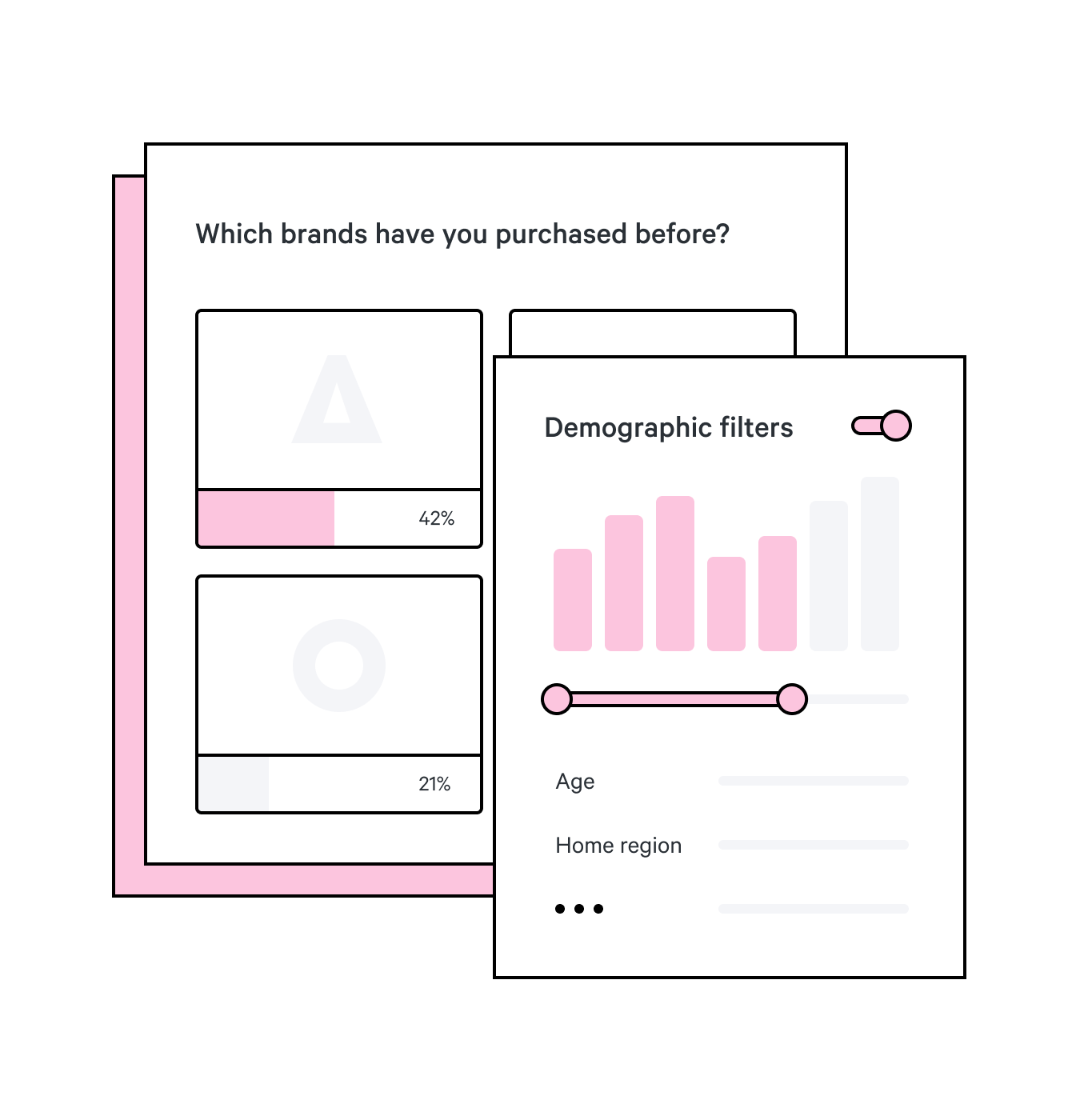A practical guide to analysing the competition in a product category

Much has been said and written about analysing competition, but we're more about the practical work. What kind of competitive analysis should you be conducting, and how do you do it best?
- What is product category analysis?
- What is a category competition analysis used for?
- Product category analysis vs competitor analysis
- How to conduct an analysis of the competition in your category
- Example of product category competition analysis done well
- What are the outputs of this analysis and next steps?
In this article, we dive into a specific area of competitive analysis: product categories. Find out what it’s all about, if it’s useful to your business and if so, how to do it the right way.
You might wonder why you would only analyse the competition of one product category, especially if your business offers a wide range of products. We’re here to show you that in some specific cases, specific research like this is the most cost-effective and will get you the most relevant data, so you can take decisions on your next steps with confidence.
Take positioning your newest product, for example, or product development. In some markets and some moments, it simply makes sense to have a laser-focus on a single product category, who’s operating in it and really getting to know their products, to the very last feature. You prevent getting a blurred picture due to other products being mixed in the equation. We’ll show you how.

What is a product category?
A product category consists of a group of products that share similar characteristics, such as physical features and similar benefits. They all solve the same issue for a specific group of consumers, and are alike. You can formulate product categories in different levels of precision.
For instance, you could look at skincare as a whole product category. But to really identify market opportunities, you’d go more specific.
Say, you take high-end moisturisers as a product category. While supermarket moisturisers are technically the same products, they fall into a different category because they target a different audience.

What is product category analysis?
For businesses looking to expand their reach, improve their product or enter a new market, product category analysis is extremely important. Product category analysis is a way of understanding the competition within your product category, as well as a general analysis of the categories themselves
You will learn to evaluate the products in your category and research what makes people buy them: what factors determine demand? You can look at features or messaging, but also sales tactics.
A product analysis like that requires talking to the target market: they are the ones who can explain how they differentiate between the products, from the consumer’s point of view.
With the insights from product category analysis, you can determine how to create a product that is in demand, how to position it in the market, and also identify opportunities for cross or upselling.
Sell more products by understanding your market better
Your target customers will become customers if you offer them products they genuinely want. Make sure you know what they want by gathering insights you can trust.
See the top research toolsWhat is product category competition?
Why are we talking about product category competition, and not about competition in general?
Because they aren’t necessarily the same.
Product category competition solely focuses on brands that sell products that are similar to yours. Their basic functions are the same, and they look alike. A consumer will see that as well.
Product category competitors all create a product that meets the same needs. So, they try to stand out by price strategies, offering additional benefits or having exceptional product features.
This is different from generic competition: this is more about what problem a product solves for the consumer. It also includes indirect competition. Competition can be categorised in many ways. There’s future competition, that looks at how technologies are evolving and might replace your product.
What is a category competition analysis used for?
The main reasons for conducting a product category competition analysis are:
- To work out the best product positioning
- To figure out what strategic advantages to double down on
- To learn what features are crucial for product development
- To identify market gaps
With product category competition analysis, you don’t just look at the products. You’ll also look at how consumers are perceiving messages from brands around those products, how they use products, and what their buying reasons are.
You’ll also investigate the tactics your competition is using to sell their products. What you’ll be focusing on depends on the main reason you are doing this research. Let’s dive in a little deeper.

Choosing your product positioning
Product positioning is all about how you want to be perceived by consumers. It’s about what you do to the mind of the prospect. In a market full of products that are seemingly alike, you will have to choose a strong market position that your target group can relate to.
Your positioning will determine a large part of your marketing strategy. What is the benefit of buying your product, from your brand, as opposed to buying from the competitor? Will you be focussing on quality or price? Availability or exclusivity? Are you selling cars like Ferrari, or Fiat?
Your marketing strategies will revolve around making that particular benefit clear to your target market, and educate them on the difference between you and what others are offering.
A popular way to determine a good place to position your product is by creating a perceptual map with two variables that are relevant to consumers. The most basic model focuses on price and quality, but you can vary. You then let consumers place your competitors (and yourself) on this map.
What are competitors focusing on and what space of the market is unoccupied? This map will show you, and you can choose to either compete on the same position as another brand, or start fresh elsewhere with your product.

Finding your strategic advantages
What strategic advantages does your business have over your competitors that could help you sell your product better? This is less about the products your competitors offer and more about your competitor’s strengths compared to yours, such as:
Business resources: do you have access to specific resources that could set you apart from others in your playing field?
Cost structure and business model: can you offer certain promotions or prices thanks to your business model or cost structure, that other businesses couldn’t do without cutting too much profit?
Processes: do you have state-of-the-art processes and systems? Are you automating busywork, which will allow you to work faster than anyone else?
Capital: are you sitting on a pile of cash that allows you to invest in certain areas that will make your products future-proof?
Room for growth: how many employees do you have onboard? In busy times, perhaps around Christmas, can you take on the extra capacity?
Flexibility: can you innovate or change lanes quickly, or is your business not set up like that? This is a combination of the processes you have, your organisational culture, but also your team.
Access to distribution channels: do you have access to distribution channels that could speed up sales or help you reach more people?

Getting ideas for product development
If you’re developing an entirely new product, you can’t skip your category competition analysis. Start by looking at the features that competitors’ products have in this category, to determine what the absolute minimum set of features should look like.
Talk to your target audience to find out what they are missing. What features do they love, and what could they live without?
Ask them: if you were the CEO of our company and could redesign this product to your liking, what would it look like and do?
Don’t just focus on the competition: your customers hold valuable information as well.
What emerging trends can you spot in the market? What are people saying in product reviews about the products your competitors offer? Find their strengths and weaknesses to create a better product than is already available in the category.
Identifying market gaps
Last but not least: using category competition analysis and competition mapping to discover new market opportunities. This could be explained as a combination of what we’ve mentioned above.
You look at positioning that isn’t being used yet, features that aren’t offered yet. Then, you calculate if that piece of the market is worth storming into.
However, it’s important to remember that, if you do find a gap in the market, don’t assume that it’s worth filling.
Sometimes, there’s no competition for a very good reason: a piece of the market is simply not profitable. You might want to read the story of chotuKool, created byIndian manufacturer Godrej.
Basically, it’s a fridge that was created for low-income Indian households. Godrej wanted to go where nobody went before and expected to sell millions. Instead, they had to rethink and reposition the product in the end – the market was simply not big enough (and their research wasn’t great either).
Product category analysis vs competitor analysis
How is a product category analysis different from a competitor analysis?
A competitor analysis is not necessarily in the same product category as yours, but they might offer the same benefits. For instance: a town has a mini-golf club and a cinema. Two completely different things, but if you’re looking for a fun date night, you consider both of them. Suddenly, they are competitors, because they are fighting for the attention of the same customers.
For a full-on effective competitive analysis, you’ll need to distinguish between direct and indirect competitors.
- Product category analysis looks at direct competitors, who offer the same products.
- Competitor analysis also focuses on indirect competitors – different products, but similar benefits.
Whichever is most relevant to you depends on what type of competitors you have. If your product doesn’t have any indirect competitors, you might focus on product category analysis, and an additional comprehensive competitive analysis will do.
But be wary of thinking you don’t have indirect competition. Many companies have made that mistake – and it’s a costly one. Satnavs were quickly replaced by smartphones. The competitive landscape also stretches out to the future: what will replace your product if technology keeps evolving at this pace?
And then there’s the risk of not looking far enough into the world. Even if you don’t operate in the same geographic area, the internet has broadened your level of competition. If you sell physical products, competition could be wherever there’s a stable Wi-Fi connection.
How to conduct an analysis of the competition in your category
To conduct a thorough analysis of the competitors in your product category, follow these steps:
- Define the problem you solve
- Define the audience you serve
- Find your category and direct competition
- Comparing product features
- Comparing pricing and target audience
- Compare marketing and reach
Are you looking for inspiration and advice from experts who have reaped the benefits of analysing what the competition is doing? Check out the advice from 20 experts who share their tips and tools for competitive analysis. And our research experts have compiled this list of essential competitor analysis questions to get you started with your research project.
1. Define the problem you solve
Look at your product as a solution or a benefit, and not as a product. What issue does your customer experience, and how do you solve it? What value are you adding to someone’s day or life when they use your product?
2. Define the audience you serve
Who’s buying your product, or who will you try to sell to? It’s important that you create a realistic audience and buyer persona. Don’t dream up a customer who doesn’t exist in reality.
When defining your target audience, it can be easy to make assumptions about their buying reasons and motives. But if you want the most accurate data, you will have to talk to them directly.
Give consumers a product they’ll actually buy!
Make sure you understand what makes your target customers tick with these top market research tools
See the listAnother part of this is mapping out the customer journey. This will help you get more insights on why customers choose one brand instead of the other, and you get insights into important touchpoints that you could be missing out on.

3. Find your category and direct competition
Combine the problem you solve with who you are solving it for, and find out what other businesses are doing the same.
One way to do that is through search engine data: what other brands do you find if you type in your products? You can also ask your target audience what other brands they would consider buying from.
4. Comparing product features
Let’s get down to the details. Take your competitor’s product and examine its key features. What are they doing better than you? How does your product compare in terms of technology and innovation? Which one is more future-proof? At this point, it is also valuable to ask your audience what features they find most important.
5. Comparing pricing and target audience
Are your competitors’ prices more or less the same as yours, or are they targeting a different part of the market with their pricing strategy? How important is the price in the eyes of your target audience?
It’s important to find out if the price is a defining factor for a successful sales strategy, or if you could play at another competitive advantage.

6. Compare marketing and reach
Alright, let’s get down to the nitty-gritty: what is your competition doing better than you when it comes to marketing, messaging, and reach? With a competitive market analysis, you look at their competitive edge.
Why shouldn’t you just focus on your own company and strategy? Because you can’t test everything, and a competitive analysis helps you see what strategies are apparently working (or not), depending on your competition’s success.
What is their unique value proposition? How are you comparing in terms of brand awareness? What customer feedback are they getting on review websites?
What are people commenting on their social media posts, and what does their social media presence look like? Analyse your competitors’ content to get a glimpse of their strategies.
Of course, it’s not just about search volume and how many people are talking about a brand, it’s also what they’re saying. You can use smart market trend analysis software and competitor tracking tools that will help you do a sentiment analysis and keep an eye on your competitors’ performance.

Example of product category competition analysis done well
To launch an effective marketing campaign abroad, Bloom & Wild knew they needed more data on the current landscape. Since they were planning on expanding to three different countries, they analysed the market they were about to enter, looking at different aspects, such as product features and marketing.
Bloom & Wild’s Head of Business Intelligence, Mairead Masterson: “We are a relatively new player in Germany and France, so we had less knowledge on how the flower landscape looked, and who the main players were in terms of customer and prospect perception. We really wanted to understand how different brands resonated with customers in their markets, and used Attest to build a picture of how our brand tracks against competitors.”
They then went on to identify drivers that would make customers adopt their product in each country. They looked at the product features and how they would work in each individual country.
The objective of performing category analysis is to understand thoroughly what prompts consumers to use your products (drivers) and what are the crucial barriers which prevent them from further embracing your offerings.
Masterson continues: “In the UK, the letterbox packaging is a core part of our proposition as it makes the experience easier for recipients, however in France and Germany people don’t tend to have letterboxes, so we needed to understand which of our other USPs were important to them. Attest is useful in times when we don’t have existing knowledge or precedents of the market or marketing channel.”
Their research left them with actionable data that helped them change and craft effective marketing materials for each market.

What are the outputs of this analysis and next steps?
Just like Bloom & Wild, it could help you communicate better with your target audience. But the insights you get can be used for more than just marketing efforts. It can be the blueprint for a solid growth plan.
What you’ll be doing with this analysis depends highly on what your goal was in the first place. Your team needs to be willing to make the necessary changes that turn out to be necessary based on your research.
Given that the market landscape often changes as technologies and trends evolve, it’s important to keep an eye on what’s happening in your product category. Check on key metrics every once in a while to see if you’re still on the right path.
Get started with Attest today
See how you can use data to make great decisions.
Tell us what you think of this article by leaving a comment on LinkedIn.
Or share it on:

